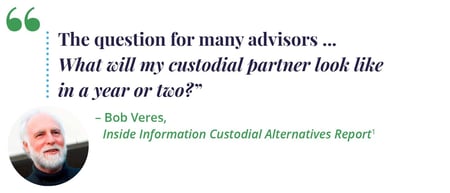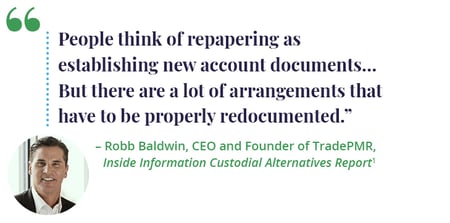Rule #1: Don’t let M&A derail your business.
With thousands of advisors approaching a major RIA custodian merger, it’s important to reflect on how these mergers have gone in the past.
As an RIA back in the 90s, Robb Baldwin’s custodian was acquired, and he was forced to navigate a RIA custodian merger. He was promised a seamless move and decided to ride it out – that ended up being a big mistake. Robb’s negative experience ultimately led him to launch TradePMR, to help make sure RIAs never had to go through what he went through.
RIAs approaching this current merger seemingly have limited information and a lot of unknowns. This uncertainty can create significant headaches for RIAs. These are advisors that are trying to manage client relationships, expand their business, and plan for the future – all while not knowing what to expect from their newly merged provider. It’s time for these advisors to figure out what’s ahead of them, and if they’re ready to put their business, and their clients, through that experience.

Robb has boiled down the potential pitfalls for RIAs navigating these mergers. These seven do’s and don’ts highlight potential issues that could arise during and after the move, as well as questions that RIAs should consider before sticking around through the merger.
The Seven Do’s and Don’ts of RIA Custodian Mergers
-
Drop in Service Levels
When navigating a custodian merger, advisors and RIA staff are thrust into a new ecosystem that they must learn to navigate on-the-fly. While getting up-to-speed on these new policies, procedures, and technologies, RIAs may be dealing with months of substandard service while the prevailing firm works to hire and train new employees. Even for basic support, mergers can create massive complications for custodian teams that can cause service disruptions.
Questions to consider: What is being communicated by your new custodian? Are they addressing fully and transparently anticipated downtime, hold times, processing times? Have they provided you with Service Level Agreements that will meet the needs of your firm, and ultimately of your clients? How many clients will you lose during this time? How much built-up good will can be lost during this time?
-
Continuity of Client Data
In today’s hyper-technical environment, nearly every RIA manages at least one integration with an outside technology vendor to streamline workflows and deliver expanded opportunities to clients. Beyond these technologies being a great tool for advisors, these integrations can be a key repository for client data. With some integrations, data can be lost when changing custodian platforms. RIAs may not be able to access or reconstruct this data (think asset-level performance tracking) – this kind of hiccup could have a long-lasting impact on a RIA’s business as they look to review this historical data in the future.
Questions to consider: Will your new custodian support these data hiccups if they occur during a transition? Will you lose historical data or are allowances being made to preserve that data for the sake of consistency? Will the same data be available with the new provider? How will the new custodian charge for integration solutions, and do those costs align with what the firm has previously been paying?
-
Barriers to Prospecting
For RIAs, the work to attract and sign profitable and loyal clients never ends. When a firm is transitioning to a custodian that has a substantial focus on retail accounts, that could pose an issue and a conflict of interest. RIA custodians that serve retail clients could potentially compete with RIAs for business, aiming to sign their clients and prospects to direct retail channel relationships – did someone say awkward?
Questions to consider: Is your custodian truly invested in your success as an RIA? Is there a possibility of your custodian poaching your hard-won clients, or swooping in on your prospects? Is your custodian 100% focused on serving your RIA, or is their attention split trying to win over retail clients? Is the custodian’s technology built with your RIA’s unique needs front-and-center?
-
Procedure and Policy Changes
When switching to any new RIA custodian, advisors should expect to find different procedures and policies. What’s important is for advisors to determine if the procedures and policies at their new custodian align with how they run their business. The merging custodians may promise no repapering, for example, but does that mean there won’t be any paperwork? It could depend on how an RIA operates. Finding the answer to that is critical. Repapering thousands of accounts may require the hiring of additional staff or paying overtime to existing staff to help limit an impact on the business.

Questions to consider: How significantly will these changes impact your clients? While accounts may port over seamlessly, will your beneficiary paperwork? Will your ACH’s, Periodic Instructions, and other documents? What about long-term changes in procedure or policy? Do the policies you face post-merger work for your staffing levels, your investment and service philosophy and most importantly, your clients? How transparent are these changes being communicated by your provider?
-
Too Small for the Big Custodian
Regardless of a RIA’s size, when they move to a larger custodian they become a smaller fish in a larger pond. As an advisor, your perceived importance to the new custodian should be apparent immediately in your first discussions with the firm. Specifically, determining how the custodian will approach service with the RIA and any kind of tiered offering that could impact the firm’s ability to get help when needed can be critical. Service is everything for RIAs and their clients. The truth is advisors cannot service their clients without the help and support of the staff from their RIA custodian. Each RIA has crafted an expectation of service times, accuracy, and diligence with clients that could be destroyed in a matter of weeks with inadequate support.
Questions to consider: Will the new custodian maintain the same level of service you’ve been receiving from your current provider? Does the custodian offer tiered service levels? If so, what level do you fall into? Based on the size of your firm, will your calls now be routed through less experienced teams with slower response times? How big is big enough to get the support you need from your new custodian?
-
Cost Changes
There are a wide range of costs associated with navigating a RIA custodian merger: retraining your own staff, repapering as needed, sending out adequate communications to your clients related to the merger, the list goes on. It’s important to not only think about these costs, but also the actual contractual costs that are likely to change with the move. From trading costs to mutual fund and bond fees, the new custodian could have a major impact on the costs passed on to clients. RIAs have a fiduciary duty to conduct due diligence on this pricing to ensure working with this new provider would still be in those clients’ best interest.
Questions to consider: What you are charged will likely depend on your AUM, so how much is “enough” to maintain your original fee structure when you transition to this new custodial relationship? Are there any hidden fees that your firm take on that you may not have been paying with your current provider? Will you have an opportunity to discuss or negotiate pricing, or will you be met with a one-size-fits-all rate sheet?
-
Navigating the Unknown
Probably one of the most understated factors when navigating a RIA custodian merger is the uncertainty. The stress, anxiety and confusion created by being thrust into a partnership that RIAs didn’t choose on their own. This can impact RIA staff, the business, and clients and shouldn’t be taken lightly. Advisors deserve to know every detail of what they are losing, what they are gaining, and how those changes will impact the firm’s day to day operations. The unfortunate truth is that many advisors can’t even get the most basic of questions answered during a merger. This is not because the answers aren’t known by the provider, but that those answers could impact advisors’ willingness to go quietly into partnership with a firm that ultimately may not meet their needs.
Questions to consider: When will the merger be finalized? Will I have support from dedicated personnel when my firm makes the move? Can I make the move now, on my own terms? When will I have answers to these questions, if not today?
Don’t Get Stuck Repeating the Past
RIAs deserve strong service and technology built to fit their needs. It’s that simple.
The major RIA custodian merger underway could go smoothly, it also could be a nightmare. The problem facing advisors is determining what makes more sense for their business: wait-and-see what will happen and risk business pains or take the move into their own hands and sign on with a custodial service provider that they actually choose.
If you’d be interested in discussing these seven do’s and don’ts in more detail and see if TradePMR could be a good provider for your firm, we should talk. We can dive into your business, your goals, and what you can expect from a transition to TradePMR’s offering.
1 Custodial Alternatives, Inside Information by Bob Veres. Published August 10, 2022.
TradePMR and Bob Veres are not affiliated.








